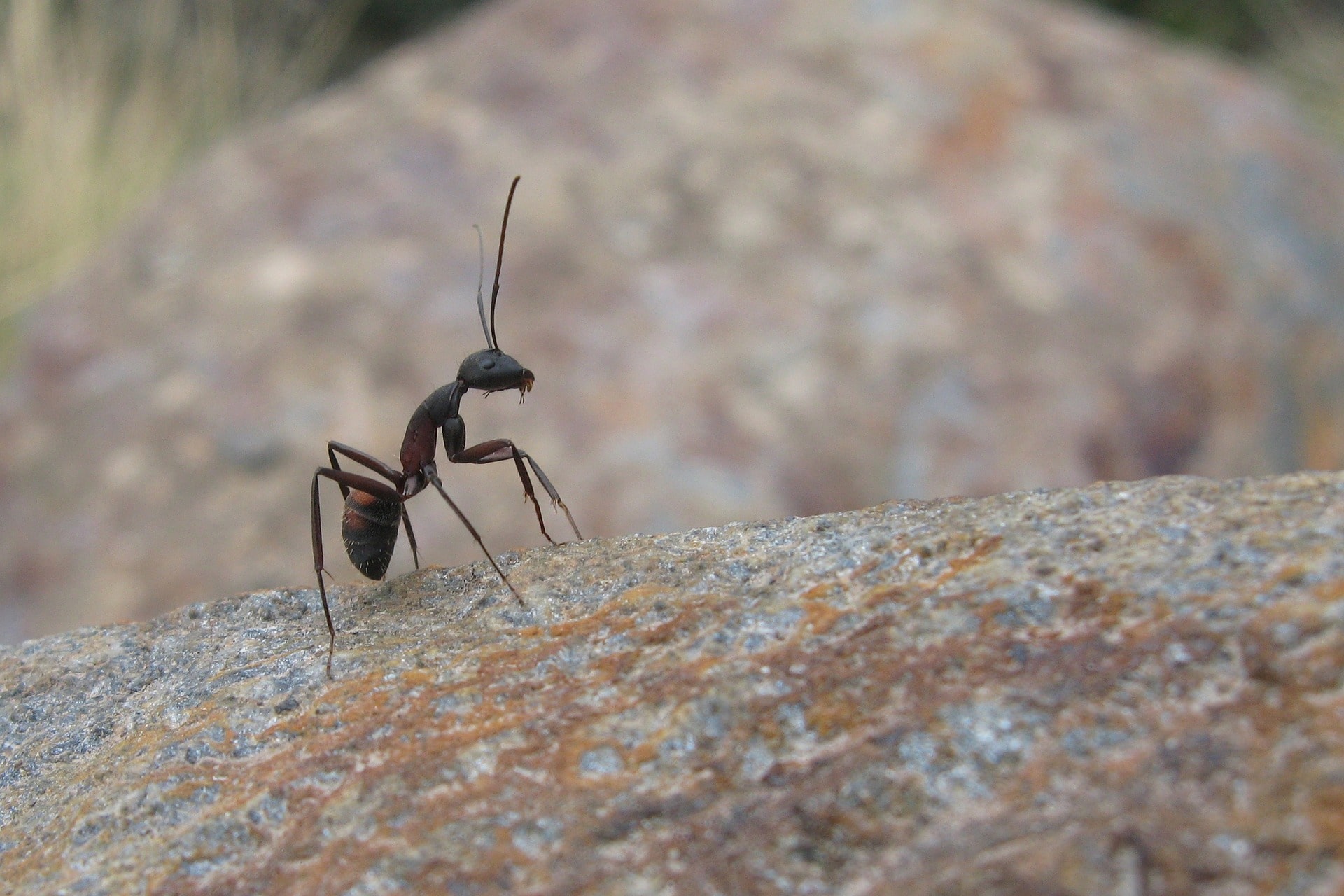Warm weather is coming as spring rolls in, pushing old man winter out. As we become more active, other creatures are stirring from a long hibernation, hungry for a snack.
Unfortunately, this reawakening includes some nasty pests that could find their next meal in your kitchen. One colony-building insect can become quite a problem if they find their way inside a home unnoticed: ants.
Small, common, and quiet, ants can often go unnoticed, but they are just about everywhere. Once inside, it can be very difficult to get rid of ants. And they can do lots of damage to your house.
If you think you may have ants or want to take steps to protect against them, this ant exterminator guide has the answers for you. Learn the signs of an infestation, how to treat one, and when you need to contact a professional ant exterminator.
Know What You Have: How to Identify Ants
Most people can easily spot ants, but this doesn’t mean they can’t be confused for other creatures. For example, carpenter ants nest in wood, much like termites, and flying ants can look like termites, making the two difficult to distinguish.
The most obvious difference between these two insects is that ants have pinched, segmented bodies. Termites do not.
However, carpenter ants are not the only ants that can damage your home or become a nuisance. The most common ants in the northeast include:
- Odorous Ants: Small brown or black ants that emit a strong, unpleasant odor when crushed; often attracted to sugary foods.
- Pavement Ants: Dark brown to black ants that build nests in pavement cracks; commonly found near sidewalks and driveways.
- Pharaoh Ants: Small, yellow ants that are notorious indoor pests, often found near moisture sources and known for rapid colony growth.
- Thief Ants: Tiny yellow to dark brown ants that are skilled scavengers, stealing food from other ant colonies.
- Acrobat Ants: Range in color from light brown to black and have a unique heart-shaped abdomen; known for raising their abdomen when disturbed.
- Fire Ants: Reddish-brown ants with a painful sting; build large mound nests and are aggressive defenders of their territory.
Find out what type of ants you are dealing with so you can assess your infestation problem and treat it properly.
Signs of an Ant Infestation
The most common sign of an ant infestation will be spotting ants in your kitchen or bathroom. However, there are a few additional signs that may point you to an unwanted ant infestation in your home.
- Presence of Ant Nests: Ant nests can vary in appearance depending on the ant species. Nests may be found in soil, walls, or other secluded areas.
- Ant Mounds: Certain ant species, like fire ants, build noticeable mounds in yards and sidewalks. The presence of these mounds suggests an infestation.
- Frass or Sawdust: Carpenter ants create nests in wood, and their activity can result in the expulsion of frass (fine sawdust) near nesting sites, indicating a potential infestation.
Where Do Ants Like to Hide?
As stated previously, ants don’t make much noise. They can quietly slip into your kitchen, and you might be none the wiser. However, unlike other pests, they are easy to spot.
If you want to stop ants from getting in, you must stop them at the source. To do that, you have to seek out where they are getting in or where they are hiding out. Nests and colonies can be outside, in hard-to-reach places, and spots that are out of place and out of mind. The trouble is a single colony can produce thousands of eggs. So, a small ant problem can get big fast.
If you happen to spot an ant, follow it and see where it goes. If you see more than one, it’s likely they are coming from somewhere nearby.
Check windows, doors, vents, and any areas with an opening small enough to slip through. If they are coming from outside, you can put a stop to it by sealing off any openings. If you spot a colony outside, you can pour boiling water on them to eliminate them. Try to find the source so you can stop them from coming back.
Know When to Call a Professional Ant Exterminator.
So, you’ve spotted a few ants in your kitchen or bathroom. A few ants here and there are no reason to raise an alarm immediately.
Since these insects are so small, it can be easy for them to sneak inside to do a little searching. Of course, you don’t want them to alert the rest of the colony, so dispose of them if you do see them. However, if you happen to find more or a bunch of them in one spot, you may have a bigger problem.
If you only see a few ants scurrying around, you can try store-bought traps or baits first. They can do the job by eliminating the invaders before they become a problem.
Most baits are made so ants will carry back the poison to the colony and destroy it from within. Of course, this plan can work if you have only a few ants. If you have bigger, more dangerous ants or clusters, you might have to do more than just put down a little trap.
Nests can be difficult to get rid of, and some ant species can pose a real threat to your home’s structure. The issue with getting rid of only a few ants is that there’s a whole colony with plenty more.
This could be a problem, even if the colony is located outside. Ants can also live long lives (up to 15 years), so a colony can continue to grow. Gauge the size of your infestation and seek out ant exterminator help accordingly.
How to Stop an Ant Infestation On Your Own
The best way to stop any pest is to keep them from getting in. Close off any possible entryways at windows and doors. You should also check chimneys, vents, and other open areas that could lead inside.
Inside, keep any areas where food is eaten or prepared tidy. Seal up any open containers, including pet food, to discourage any scouts from returning home. If you have a smaller infestation or a few stray ants, try ant baits or traps. Make sure you set them close to where the ants are coming in and away from kids and pets.
If the infestation is too large, or you are dealing with fire ants or carpenter ants, it may be best to seek out an expert ant exterminator.
Ant Exterminator Costs
Depending on who you go with, costs can vary. The average cost overall is $250 for ant extermination, not including fire or carpenter ants.
A visitation and extermination, depending on the type of ants you have and the size of the infestation, is usually from $150 to up to $395. If you don’t want to deal with a sudden infestation, some companies offer year-round protection for a fair price. It’s also possible to get your yard treated to stop any invaders before they get near your home.
The key here is to stop the infestation before it becomes a problem. Be vigilant, perform regular maintenance on your home, and call in the professionals when needed.
Concluding Thoughts
As the warm weather returns, you don’t want to worry about ants ruining your picnic or your home, for that matter. Arm yourself with the knowledge needed to spot the issue and take down these pests before they eat you out of house and home. With this handy guide, you can safely identify your issue and give it the attention needed.
Ant Exterminator FAQs
How long does ant extermination take?
The duration of ant extermination can vary depending on the extent of the infestation, the ant species, and the chosen extermination method. Sometimes, it may take a few days to see results, while more extensive infestations might require ongoing treatment over weeks. Professional exterminators can provide a more accurate estimate after assessing the specific situation.
Are the chemicals used safe for pets?
Many extermination chemicals can be harmful to pets, so it’s crucial to choose pet-safe options. Some professional pest control services use pet-friendly formulations, and they will provide guidance on keeping pets away from treated areas during and after the extermination process. Additionally, natural and non-toxic alternatives can be considered to ensure the safety of pets.
Are there eco-friendly ant extermination products or methods?
Yes, there are eco-friendly ant extermination options available. Some methods include the use of natural deterrents like vinegar, lemon, peppermint oil, or diatomaceous earth. Additionally, certain professional pest control services offer eco-friendly solutions that use less harmful chemicals. It’s essential to communicate your preference for eco-friendly methods with the exterminator and inquire about specific products or techniques that align with environmentally conscious practices.





























